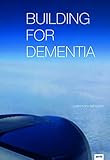Building for Dementia / Christoph Metzger.
Material type: TextPublisher: Berlin : JOVIS, [2018]Copyright date: ©2018Description: 1 online resource (160 p.) : ca. 70 farb. und 10 s/w AbbContent type:
TextPublisher: Berlin : JOVIS, [2018]Copyright date: ©2018Description: 1 online resource (160 p.) : ca. 70 farb. und 10 s/w AbbContent type: - 9783868594782
- 9783868599329
- Alzheimer
- Anforderungen
- Architektur
- Beeinträchtigungen
- Demenz
- Farbgestaltung
- Haptisch
- Klangdesign
- Leitfaden
- Lichtgestaltung
- Materialien
- Orientierung
- Raumatmosphäre
- Sicherheit
- Wohnen
- Wohnsituationen
- demografischer Wandel
- kognitive Fähigkeiten
- motorische Fähigkeiten
- multisensorische Architektur
- räumliche Umgebung
- sinnlich erfahrbar
- ARCHITECTURE / Study & Teaching
- 725/.53 23/eng/20230216
- online - DeGruyter
- Issued also in print.
| Item type | Current library | Call number | URL | Status | Notes | Barcode | |
|---|---|---|---|---|---|---|---|
 eBook
eBook
|
Biblioteca "Angelicum" Pont. Univ. S.Tommaso d'Aquino Nuvola online | online - DeGruyter (Browse shelf(Opens below)) | Online access | Not for loan (Accesso limitato) | Accesso per gli utenti autorizzati / Access for authorized users | (dgr)9783868599329 |
Frontmatter -- Contents -- Foreword -- Rethinking Architecture -- Roads and Paths through Life -- Bodies in Motion—Stimulations -- Age and Orientation -- Cognitive Skills -- Localization of Acoustic Events in Space -- Types of Housing for the Elderly -- Multisensory Architecture -- Assistive Systems and Smart Homes -- Private and Public Spheres -- Inclusion or Exclusion -- Prospect of an Architecture of the Future -- Acknowledgments -- Bibliography -- Notes -- Captions/Picture credits -- Imprint
restricted access online access with authorization star
http://purl.org/coar/access_right/c_16ec
As a consequence of demographic change, it is increasingly necessary now and in the future for the architectural profession to rethink the design of residential solutions for aging people and especially those with dementia. With advancing age we are increasingly dependent on a spatial environment that not only has a positive effect on us, but also supports our everyday activities and takes age-related restrictions into account.A focal point of the new requirements is multisensory architecture: color and lighting design, sound design, tactile materials and surfaces, and haptically attractive forms, creating a spatial atmosphere in which the resident feels comfortable, providing security and orientation and fostering motor skills and cognitive abilities. Bauen für Demenz (Building for Dementia) has been developed as a guideline for contemporary and dignified architecture that meets the requirements of people with dementia and views them as an integral part of society.
Im Zuge des demografischen Wandels ist die Architektur heute und in der Zukunft mehr denn je gefordert, die Gestaltung von Wohnsituationen für alternde Menschen und vor allem solche mit Demenz neu zu denken. Mit zunehmendem Alter sind wir mehr denn je auf eine räumliche Umgebung angewiesen, die uns nicht nur positiv beeinflusst, sondern vor allem in unseren Alltagsaktivitäten unterstützt und altersbedingte Beeinträchtigungen ausgleicht. Im Zentrum neuer Anforderungen steht eine multisensorische Architektur: Farb und Lichtgestaltung, Klangdesign, sinnlich erfahrbare Materialien und Oberflächen sowie haptisch attraktive Formen ermöglichen erst eine Raumatmosphäre, in der Bewohner sich wohlfühlen. Diese bietet Sicherheit und Orientierung und fördert motorische und kognitive Fähigkeiten. Bauen für Demenz wurde als ein Leitfaden für eine zeitgemäße und würdevolle Architektur entwickelt, die Menschen mit Demenz gerecht wird und sie als inklusiven Teil der Gesellschaft versteht.
Issued also in print.
Mode of access: Internet via World Wide Web.
In English.
Description based on online resource; title from PDF title page (publisher's Web site, viewed 06. Mrz 2024)


